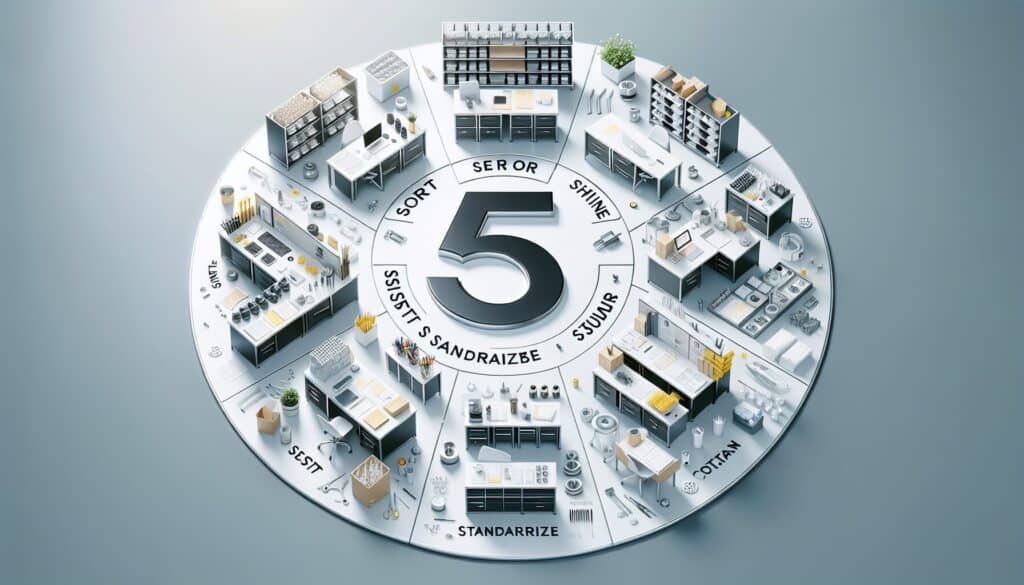A workplace organization method based on five Japanese words: Seiri (Sort), Seiton (Set in Order), Seiso (Shine), Seiketsu (Standardize), and Shitsuke (Sustain), aiming to create a clean, organized, and efficient work environment.
- 方法: 工程, 质量
5S

5S
- 5S 方法, 持续改进, 效率, 精益制造, 流程改进, 生产率, 质量管理, 安全, 减少废物
目标
如何使用
- SORT: Remove unnecessary items. SET IN ORDER: Arrange necessary items for easy access. SHINE: Clean the workplace. STANDARDIZE: Implement standards for the first three S's. SUSTAIN: Maintain the standards through discipline and continuous improvement.
优点
- Improves safety, quality, and efficiency; Reduces waste (e.g., wasted motion, search time); Creates a more pleasant and productive work environment; Simple to understand and implement with team involvement.
缺点
- Requires ongoing effort and discipline to sustain (Shitsuke is the hardest); Benefits may not be immediately quantifiable in financial terms; Can face resistance if perceived as just a housekeeping exercise without understanding the deeper benefits.
类别
- 人体工程学, 精益西格玛, 制造业, 项目管理, 质量
最适合:
- Creating and maintaining an organized, clean, safe, and efficient workplace to improve productivity and reduce waste.
这 5S methodology finds its application across various industries such as manufacturing, healthcare, and offices, effectively integrating into lean production processes. During the initial project phase, teams engage in 分选 through existing inventory and eliminating any tools or materials that do not contribute value, a task often initiated by team leaders or management. The next phase focuses on “Set in Order,” where items essential for daily operations are strategically organized based on their frequency of use, enhancing accessibility and minimizing time wasted searching for equipment. “Shine” encourages regular cleaning schedules that not only enhance the aesthetic appeal but also proactively identify maintenance issues that could disrupt operations. Following that, the “Standardize” phase develops specific procedures and guidelines to ensure that the practices established in the first three S’s are acknowledged and adhered to by all staff. The final phase, “Sustain,” emphasizes the importance of continuous training and periodic audits to reinforce these practices among employees, fostering a culture of accountability and improvement. Organizations implementing 5S often experience a marked increase in safety since clutter and disorganization can lead to accidents, while the enhanced orderliness supports superior quality control and operational efficiencies. Active participation from all levels of staff is encouraged, as collective engagement increases the sense of ownership and motivation, leading to sustained improvements in a tidy, well-organized environment.
该方法的关键步骤
- Remove unnecessary items from the workspace.
- Arrange necessary items for easy access and visibility.
- Clean the workspace regularly to maintain hygiene and order.
- Implement and document standards for maintaining organization and cleanliness.
- Maintain discipline to adhere to standards and encourage continuous improvement.
专业提示
- Conduct regular audits using a cross-functional team to identify areas for improvement and reinforce adherence to the 5S methodology.
- Utilize visual management techniques like 颜色编码 and signage to enhance the visibility of tools and resources, facilitating quick access and minimizing search time.
- Establish a feedback loop with team members for continuous improvement, encouraging suggestions and lessons learned to refine and sustain 5S practices.
历史背景
1960
1980
1983
1990
1995
2000
2010
1950
1980
1980
1986
1994
1995
2000
(如果日期不详或不相关,例如 "流体力学",则对其显著出现的时间作了四舍五入的估计)。














相关文章
蒙特卡罗模拟
基于模型的测试
型号检查
混合方法研究
防错(Poka-Yoke)
任务简介测试